Image diagnoses for "Eyelid"
61 results with 153 images
Results forEyelid

Borrelia lymphocytoma L98.8
Lymphadenosis cutis benigna, tumor encompassing the entire lower eyelid, tightly elastic, since 4 months after insect bite.

Hidrocystoma D23.L
Hidrocystoma: Infraorbital localized bluish-white cystic nodule in a 61-year-old man with telangiectasia.
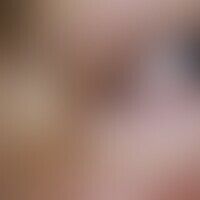
Hidrocystoma D23.L
Hidrocystoma: In this 62-year-old man a solitary, black, calotte-shaped, indolent elevation in the region of the right lower lid, a so-called hidrocystoma noire, has existed for one year.

Bubbles
Vesicles: Multiple, acute, grouped, 0.1 cm large, itchy, burning, white, smooth vesicles with a red border that have existed for 2 days in herpes simplex infection.

Blepharitis erythematosa H01.1

Atopic dermatitis (overview) L20.-
Eczema, atopic. isolated eyelid infestation with brownish discoloration, Dennie Morgan infraorbital fold and slight lichenification of the lower eyelids
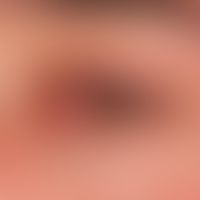
Erythema multiforme, minus-type L51.0
Erythema exsudativum multiforme; distinct conjunctivitis, inflammatory crusty changes of the eyelid margins.

Pyogenic granuloma L98.0
Granuloma pyogenicum (pyogenic granuloma) Detail view of a solitary, since 6 weeks size progressive, exophytic growing, soft, smooth shiny, otherwise asymptomatic red tumor localized on the left upper lid in an 8-year-old girl.

Infant haemangioma (overview) D18.01
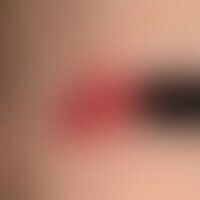
Infant haemangioma (overview) D18.01

Infant haemangioma (overview) D18.01

Herpes simplex virus infections B00.1
Herpes simplex virus infection; grouped, centrally navelled, partially eroded vesicles under the eye.

Apocrine hidrocystoma L75.8
Hidrocystoma, apocrine. remark: solitary cysts of the lid margin are rather evaluated as apocrine cysts, but histological differentiation is often not possible (see also Hidrocystoma, eccrine)

Hordeolum H00.01
Hordeolum. solitary, acute (existing since 7 days), 0.5 cm high, bulging, strongly painful, red, smooth lump with surrounding reflex erythema. Occurs in a 10-year-old girl in the region of the right epicanthus.

Hordeolum H00.01
Hordeolum. solitary, acute (existing for a few days), 0.5 cm high, bulging, considerably painful, red, smooth lump with surrounding reflex erythema.

Hyperpigmentation postinflammatory L81.0
Hyperpigmentation, postinflammatory. sharply limited brownish spot in the area of the medial inner eye angle of a 17-year-old patient with atopic eczema.
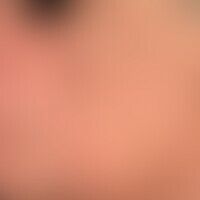
Hyperpigmentation postinflammatory L81.0
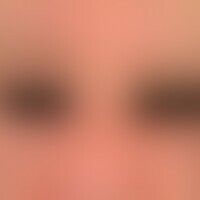
Hyperpigmentation postinflammatory L81.0

Hyperpigmentation postinflammatory L81.0

Eyelid dermatitis (overview) H01.11
Contact allergic eyelid eczema, exacerbation of skin changes after application of eyelid cosmetics.
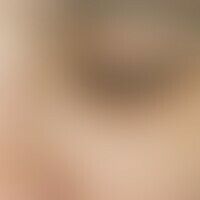
Eyelid dermatitis (overview) H01.11
Atopic dermatitis of the eyelid: Low dermatitic reaction; conspicuously marked brownish (halo-like) hyperpigmentation of the lower eyelid (slightly pronounced in the upper eyelid area); unpleasant, permanent itching.
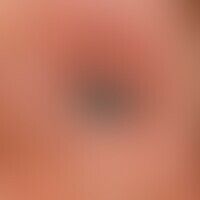
Eyelid dermatitis (overview) H01.11
Atopic eyelid dermatitis: atopic eyelid dermatitis in a 62-year-old man, with distinct periorbital redness, blepharitis, swelling and injection of the conjunctiva. Double row of eyelashes (distichiasis). The lower third of the pupil shows a veil-like opacity (pterygium conjunctivae) possibly as a consequence of constant rubbing of the eyelashes.

Eyelid dermatitis (overview) H01.11
Atopic eyelid dermatitis: chronic recurrent atopic eyelid eczema with blurred, distinctly consistency increased, severely itching, periborbital localized red, rough plaques in a 62-year-old man; distinct blepharitis with considerable swelling of the eyelids; severe injection of the conjunctiva; for many years allergic bronchial asthma and rhinoconjunctivitis allergica.
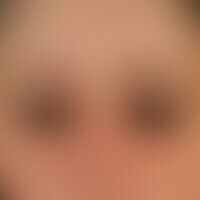
Eyelid dermatitis (overview) H01.11
Atopic eyelid dermatitis: brownish hyperpigmentation of the lower lid (more subtle on the upper lid) in a 32-year-old female patient with atopic eyelid dermatitis, who also reported strongly itchy "flexor eczema".
